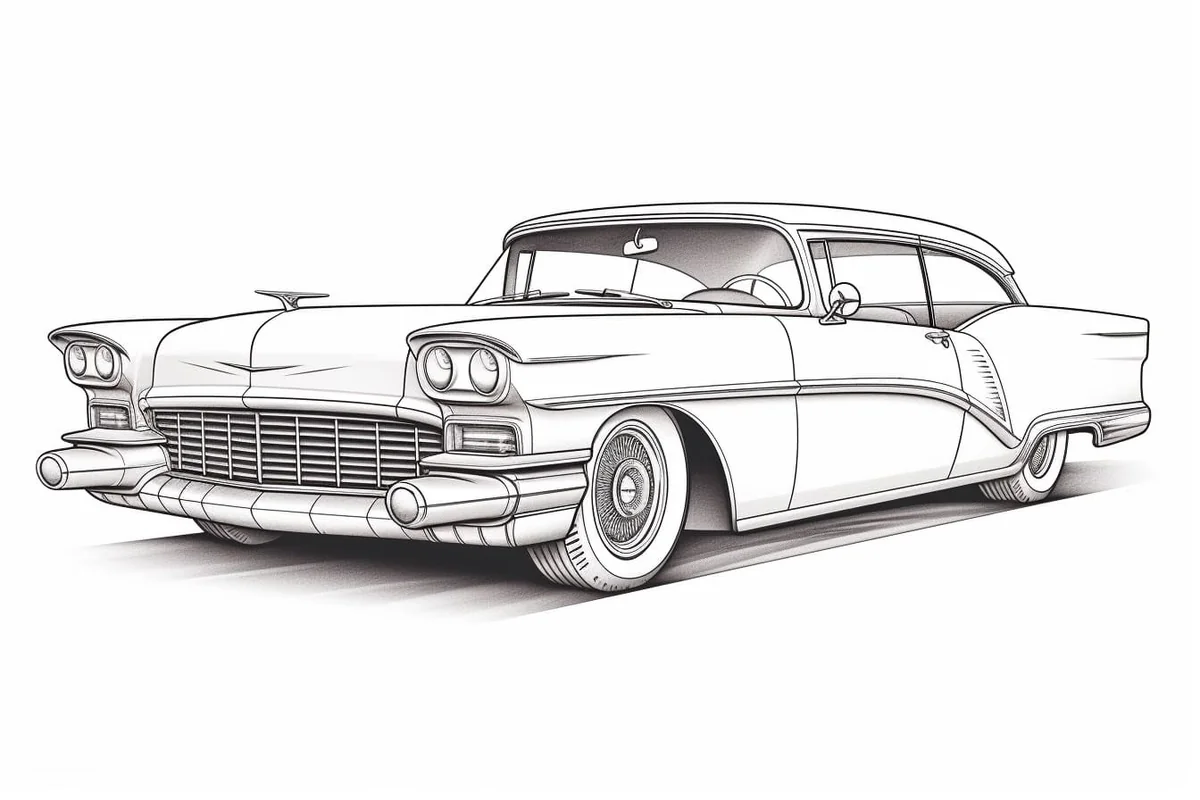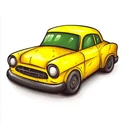How to Draw a Classic Car
Learn how to draw with this step-by-step tutorial.

Materials You'll Need
- Drawing paper
- Pencil (HB or 2B)
- Eraser
- Colored pencils
- Markers
- Ruler

If you've ever dreamed of capturing the essence of a classic car on paper, you're in for an exciting journey. Whether you're a passionate car enthusiast, an aspiring artist honing your skills, or simply someone looking to explore a new hobby, drawing a classic car offers a unique blend of creativity and technical challenge. The distinctive curves, sleek lines, and vintage charm of classic cars are not only visually appealing but also provide a fantastic opportunity to improve your drawing abilities.
In this step-by-step guide, we'll break down the process of how to draw a classic car into manageable parts, ensuring that you can follow along regardless of your current skill level. Every stage will be thoroughly explained, from laying the foundational shapes to adding intricate details. So, gather your drawing materials and prepare to immerse yourself in the delightful world of automotive art. Whether you aspire to create a realistic depiction or have fun with a stylized version, this guide is tailored to help you achieve your vision.
Now, without further ado, let's rev up those creative engines and dive into the exciting art of drawing a classic car! With your pencil and paper at the ready, you'll soon find yourself sketching a piece that not only reflects your artistic flair but also pays homage to the timeless beauty of these magnificent machines.
Materials Required
Before we begin, make sure you have the following materials:
-
Pencil (HB or 2B)
-
Ruler
-
Fine-tip markers or colored pencils (optional for adding color)
Now that you have all your materials ready, let's dive into drawing a classic car step-by-step.
Step 1: Basic Shapes
Every drawing starts with basic shapes, and drawing a classic car is no exception. Begin by lightly sketching the basic shapes that make up the car's body. Classic cars often have a long, rectangular shape with rounded edges.
Start by drawing a horizontal rectangle for the car's main body. Then, add a smaller rectangle on top of it for the roof. Sketch two circles for the wheels, making sure they are evenly placed at the bottom of the car's body.
Step 2: Outline the Body
Using the basic shapes as a guide, start outlining the car's body. Begin with the main body, following the lines of the rectangle and adding curves for the front and rear bumpers.
Next, outline the roof, making sure it flows smoothly from the main body. Pay attention to the angles and curves of the classic car's design, as this will give it its distinctive look.
Step 3: Define the Details
Now that you have the basic outline, it's time to add some details to your classic car drawing. Start by sketching the front grille, headlights, and taillights. Classic cars often have unique and intricate grille designs, so take your time and add as much detail as you'd like.
Next, add the door handles, side mirrors, and any other features that are specific to the classic car you're drawing. Look up reference images to ensure accuracy and capture the unique character of the car.
Step 4: Wheels and Tires
Let's move on to the wheels and tires. Start by adding the spokes and rims to the wheels. Classic cars often have stylish and detailed wheels, so take your time and sketch the details carefully.
Next, draw the tires, making sure they are in proportion to the rest of the car. Pay attention to the thickness of the tires and the grooves on the tread pattern.
Step 5: Windows and Windshield
Now it's time to add the windows and windshield to your classic car drawing. Start by drawing the shape of the windshield, making sure it follows the curve of the roof. Then, add the side windows and rear window, again following the lines of the car's body.
Step 6: Fine Details
To give your classic car drawing that extra level of realism, add some fine details. This can include things like door seams, side vents, and any other small features that are present on the car.
Take your time with the fine details and use reference images to ensure accuracy. These small touches will add depth and dimension to your drawing.
Step 7: Shading and Highlights
To make your classic car drawing truly come to life, add shading and highlights. Start by identifying the light source in your drawing and determine where the shadows will fall.
Using your pencil, add shading to the areas of the car that would be in shadow. Gradually build up the darkness of the shadows, using light, even strokes.
Next, use your eraser to create highlights on the car's body. This will make the car appear more three-dimensional and add a sense of depth.
Step 8: Optional Coloring
If you'd like to add some color to your classic car drawing, now is the time to do so. Use fine-tip markers or colored pencils to carefully color in the different parts of the car.
Refer to reference images or your own imagination to choose the colors you'd like to use. Classic cars often come in a variety of vibrant and eye-catching colors, so don't be afraid to get creative.
Tip: To achieve the perfect proportions and capture the essence of a classic car, start by breaking down the car's form into basic geometric shapes like rectangles and circles. Use a light pencil (like 2H) to sketch these shapes, focusing on the overall silhouette before adding details; this will ensure that your proportions are accurate and give you a solid foundation to build on. Pay close attention to the car's distinctive lines and curves, especially around the fenders and windows, as these features define its character. Once you're satisfied with the basic structure, gradually transition to a softer pencil (like HB or 2B) for detailing, allowing you to create smooth lines and shading. Remember to reference images of the specific classic car you're drawing, as this can provide invaluable insight into its unique features and help you capture its spirit more authentically.
Conclusion
Drawing a classic car can be a fun and challenging task, but with the right guidance and practice, anyone can create a stunning piece of artwork. By following these step-by-step instructions and paying attention to the details, you can bring the elegance and timeless beauty of classic cars to life on paper.
So, grab your pencil and get started on your classic car drawing today. With a little patience and creativity, you'll be amazed at what you can create. Happy drawing!
Gallery of Classic Car Drawings






Fun Facts About Classic Cars
-
Classic cars are typically defined as vehicles that are at least 20–30 years old, celebrated for their design, craftsmanship, and cultural significance. They often represent major milestones in automotive history and innovation.
-
The Ford Model T, introduced in 1908, was the first mass-produced car, revolutionizing transportation by making automobiles affordable for everyday Americans. Over 15 million were sold by the time production ended in 1927.
-
Many classic cars were hand-assembled, allowing for a level of detail and craftsmanship rarely seen today. Unique styling and artistic flourishes were the norm before the rise of modern automation.
-
The 1950s and 1960s marked a golden age of car design, featuring extravagant chrome details, tail fins, and bold two-tone paint schemes that reflected the era's fascination with space-age aesthetics and luxury.
-
Classic interiors were distinctive, with analog dashboards, real wood trim, and bench seats offering a cruising experience that's worlds apart from today's tech-heavy cockpits.
-
Muscle cars are a beloved subcategory of classics, known for their throaty V8 engines and iconic designs. The Mustang, Camaro, and Charger stand out as American legends that continue to inspire enthusiasts.
-
Some classic cars are valuable investments, appreciated not only for their beauty but for their potential to gain value over time. Models like the Jaguar E-Type and Mercedes-Benz 190 have become prized collector items.
-
Whitewall tires were once a coveted symbol of luxury, particularly in the mid-20th century. Today, they're a nostalgic favorite among restorers aiming for period-accurate detail.
-
The Volkswagen Beetle remains one of the most iconic cars ever made, instantly recognizable for its rounded silhouette and cultural impact. It's also one of the best-selling vehicles of all time.
-
Vintage car events bring enthusiasts together worldwide, from local meetups to historic gatherings like the Barcelona-Sitges International Vintage Car Rally, celebrating the golden age of motoring in style.
Suggestions for Scenes and Settings for Classic Car Drawings
-
Downtown Cruise-In: Draw a lineup of classic cars parked on a main street at sunset, with neon signs glowing and people admiring the chrome.
-
Garage Restoration Scene: Picture a car in mid-restoration, surrounded by tools, oil cans, and posters of vintage pin-up art and racing legends.
-
Desert Road Trip: Illustrate a classic convertible speeding down an open highway through the desert, with mountains, cacti, and dust trails behind.
-
1950s Drive-In Theater: Create a nostalgic scene with classic cars parked in rows, popcorn buckets on dashboards, and a movie playing under the stars.
-
Rainy Day Reflections: Depict a single vintage car under a streetlight in the rain, its shiny body reflecting puddles and the soft glow of city lights.
-
Racing the Sunset: Show a muscle car roaring down a coastal road, tires screeching and the setting sun painting the sky orange and pink.
-
Barn Find Surprise: Imagine a forgotten classic car covered in dust and hay inside a rundown barn, with light streaming through the wood slats.
-
City Showroom: Draw a glamorous scene with a gleaming classic car on display in a mid-century showroom with big glass windows and dramatic lighting.
-
Car and Driver Portrait: Illustrate a proud driver leaning on their polished car, perhaps in a leather jacket or with a scarf blowing in the breeze.
-
Fantasy Crossover: For a fun twist, put a classic car in an unusual setting—like a retro-futuristic city, a cartoon-style race, or a dreamlike pastel cloudscape.